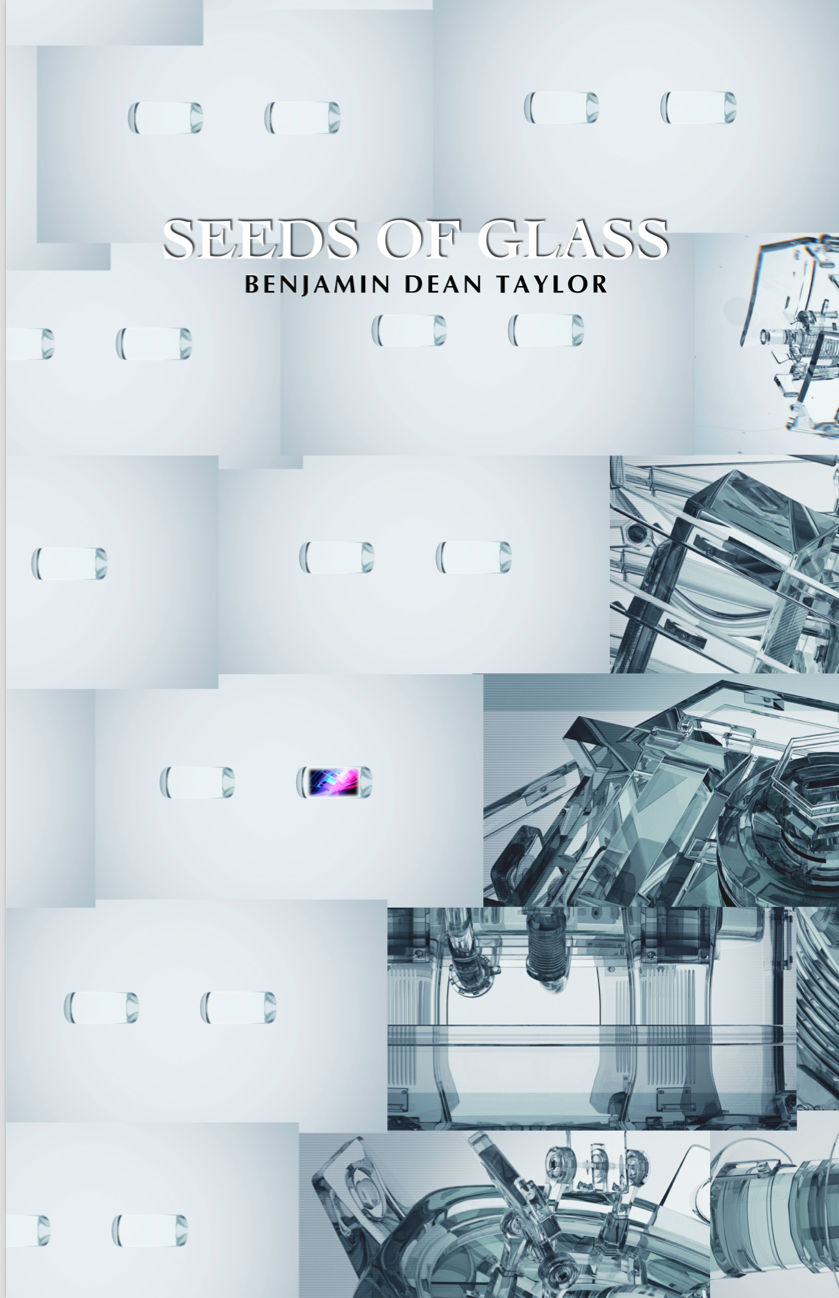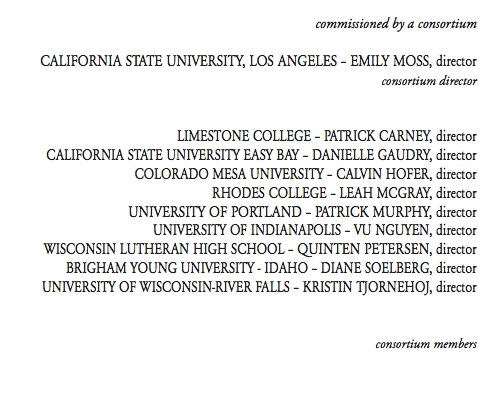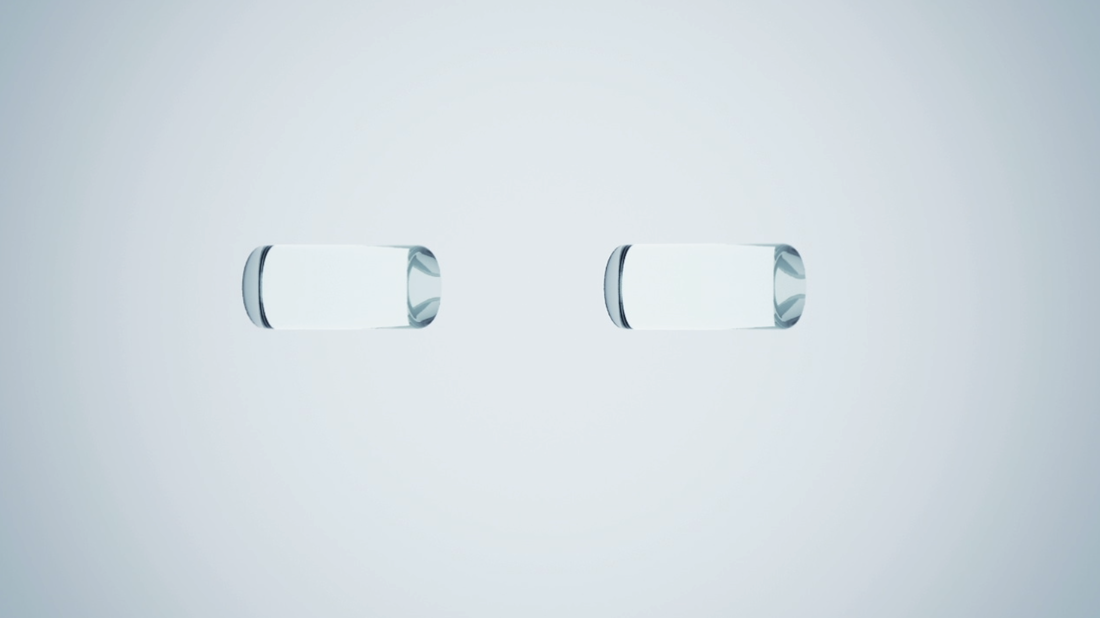Seeds of Glass
|
Commissioned by a consortium led by
Dr. Emily A. Moss http://www.emilyamoss.com Director of Bands and Director of Instrumental Music Education for the Department of Music, Theatre and Dance at California State University, Los Angeles. |
Seeds of Glass explores the intersection of nature and technology. The video portrays the evolution of a huge machine made of glass. The machine starts as a seed and slowly grows and expands, continuously progressing; similar to a living organism. The music from the band reflects this duality of nature and technology by blending lush, open sonorities with a dubstep influenced, electronic-dance-music groove.
SCREENSHOTS FROM VIDEO
Perusal Score
| seedsofglassscore.pdf |
Recordings
And here is the premiere by Emily Moss and CAL State LA.
Purchase
Please click in the field below to select PDF or hard copy purchase options. Then provide band director name, email address, and School/Institution name and click "Add to Cart." All hard copy options include free shipping to continental USA.
For all other payment arrangements, please email [email protected]
Purchase price includes a link to download the video and rights to show the video with any performance of the work.
Purchase price includes a link to download the video and rights to show the video with any performance of the work.
Information about Video
VIDEO SETUP: This work is for wind band and video. There is no audio included in the video file and thus no speakers are needed for the performance of this work. The video is to be projected onto a screen near the band (depending of the performance space this may be to the side, behind or above). The conductor must be able to see the video in order to pace the music correctly. Therefore, if the projected video is not easily visible to the conductor, a video monitor will be required. The band should use stand lights so that all other lights in the performance space can be shut off in order for the video to deliver it's full cinematic impact.
SYNCHRONIZATION: There is no click track. For the majority of the piece the band and video do not require strict synchronization. When synchronization is desired, the score provides fermatas and variable ritardandos to facilitate this. At such moments, a brief description of the video scene as well as the exact timing is indicated on the score. These are provided for rehearsal only, so that the conductor may get familiar with the video cues. Strict observance of tempos is encouraged. The conductor may easily rehearse this work by displaying the video on a laptop or Ipad during rehearsal. In performance, a video technician will be required to hit play on the video at the exact moment that the conductor gives the starting downbeat. No stopwatch or counter should be needed. The video itself, not the timings, provides the conductor synchronization cues.
VERSIONS OF THE VIDEO: There are two versions of the video. One is "fixed" meaning that the video is all one file, and one is "flexible" meaning that the video is divided into many small files. Here is a detailed explanation of the two options:
1) Fixed version. The advantage of this version is that a technician needs only to hit play on the video at the initial downbeat. No score following is required.
2) Flexible version. The advantage of this version is that the conductor can be more elastic with tempos because an assistant is triggering the video cues.
FLEXIBLE VIDEO DETAILS: This version separates the original video file into 9 parts to make it easier for the conductor to line up with the video at desired moments of synchronicity. The conductor will still need to be able to see the video in rehearsal and performance in order to coordinate with the video. Please note that the timing indications printed in the score are for the Full Track Video Version only, and thus do not apply to this Flexible Video Version. However, all of the written descriptive video cues still apply.
Download the 9 video files and put them into a playlist in either iTunes or VLC. They must be in the correct order (named “Flex 1-9”). A technician assistant will begin the first video clip at the downbeat of the beginning of the work. The technician must advance to the next track at the designated cues as follows:
Measure 12
Letter B
Letter C
Measure 26
Letter E
Measure 148
Letter T
Letter X
Each track intentionally has extra material at the end of it so to allow for slight deviances in tempo (just in case the tempo has lagged). It is still important that the conductor try to stay very close to the written tempos. Do not think that each track must play all the way through before the start of the next track. They were not designed that way. The technician advances tracks at the exact moment the conductor gives the downbeat of the next cue regardless of how much of the file is still left to play. The technician will preferably be a musician as they must be able to follow along with a copy of the score. It is strongly suggested that the technician's score be prepared with arrows or something at the above mentioned cue points.
IMPORTANT NOTE ABOUT ITUNES PLAYBACK: iTunes has a really annoying default of "remembering" where you last stopped a track and then playing the movie from that position rather than the beginning. This is extremely problematic for this piece. The technician MUST disable this feature before rehearsal and performance. To do this: Right click on the track in iTunes and select "Get Info". In the window that appears you will click a tab labeled "Options". Now un-check the box next to "Remember Playback Position." If you are running the flexible version, you must do this for all 9 tracks. If you have any questions whatsoever, please don't hesitate to contact me directly. [email protected]
SYNCHRONIZATION: There is no click track. For the majority of the piece the band and video do not require strict synchronization. When synchronization is desired, the score provides fermatas and variable ritardandos to facilitate this. At such moments, a brief description of the video scene as well as the exact timing is indicated on the score. These are provided for rehearsal only, so that the conductor may get familiar with the video cues. Strict observance of tempos is encouraged. The conductor may easily rehearse this work by displaying the video on a laptop or Ipad during rehearsal. In performance, a video technician will be required to hit play on the video at the exact moment that the conductor gives the starting downbeat. No stopwatch or counter should be needed. The video itself, not the timings, provides the conductor synchronization cues.
VERSIONS OF THE VIDEO: There are two versions of the video. One is "fixed" meaning that the video is all one file, and one is "flexible" meaning that the video is divided into many small files. Here is a detailed explanation of the two options:
1) Fixed version. The advantage of this version is that a technician needs only to hit play on the video at the initial downbeat. No score following is required.
2) Flexible version. The advantage of this version is that the conductor can be more elastic with tempos because an assistant is triggering the video cues.
FLEXIBLE VIDEO DETAILS: This version separates the original video file into 9 parts to make it easier for the conductor to line up with the video at desired moments of synchronicity. The conductor will still need to be able to see the video in rehearsal and performance in order to coordinate with the video. Please note that the timing indications printed in the score are for the Full Track Video Version only, and thus do not apply to this Flexible Video Version. However, all of the written descriptive video cues still apply.
Download the 9 video files and put them into a playlist in either iTunes or VLC. They must be in the correct order (named “Flex 1-9”). A technician assistant will begin the first video clip at the downbeat of the beginning of the work. The technician must advance to the next track at the designated cues as follows:
Measure 12
Letter B
Letter C
Measure 26
Letter E
Measure 148
Letter T
Letter X
Each track intentionally has extra material at the end of it so to allow for slight deviances in tempo (just in case the tempo has lagged). It is still important that the conductor try to stay very close to the written tempos. Do not think that each track must play all the way through before the start of the next track. They were not designed that way. The technician advances tracks at the exact moment the conductor gives the downbeat of the next cue regardless of how much of the file is still left to play. The technician will preferably be a musician as they must be able to follow along with a copy of the score. It is strongly suggested that the technician's score be prepared with arrows or something at the above mentioned cue points.
IMPORTANT NOTE ABOUT ITUNES PLAYBACK: iTunes has a really annoying default of "remembering" where you last stopped a track and then playing the movie from that position rather than the beginning. This is extremely problematic for this piece. The technician MUST disable this feature before rehearsal and performance. To do this: Right click on the track in iTunes and select "Get Info". In the window that appears you will click a tab labeled "Options". Now un-check the box next to "Remember Playback Position." If you are running the flexible version, you must do this for all 9 tracks. If you have any questions whatsoever, please don't hesitate to contact me directly. [email protected]
Ben and Emily discussing the piece at Midwest 2016
Video edited and produced by Benjamin Dean Taylor. Video source material provided by Mike Winkleman (beeple-crap.com) under creative commons license.
Music and video copyright 2016 by Benjamin Dean Taylor, Bloomington Indiana. All Rights Reserved.
Music and video copyright 2016 by Benjamin Dean Taylor, Bloomington Indiana. All Rights Reserved.






